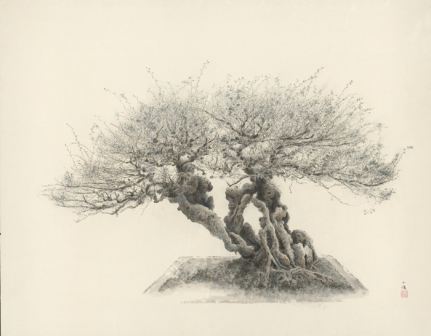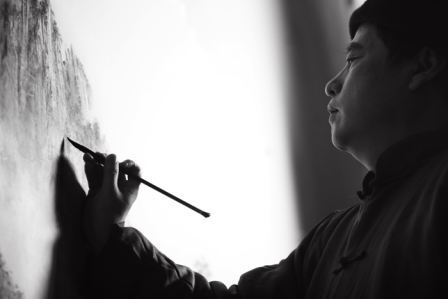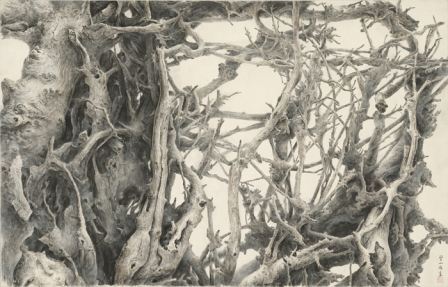“When the water of the River Canglang is clear, I rinse the ribbons of my hat; when the water of the River Canglang is murky, I rinse my feet.”
Qu Yuan, Elegies

This autumn, Zeng Xiaojun from China is cultivating a garden at the heart of London. A selection of his most stunning trees – his favourite motif – await discovery in the British capital. Following the line of the Song dynasty painter-poets, the artist continues writing, in the 21st century, the history of ink painting.
Because we are convinced that the West looks Eastward, that the East looks Westward, and that these glances when crossed carry an undeniable fecundity, we have decided to create a weekly newsletter to explore with you the reports which maintain these two artistic spheres.
Developed in partnership with Art Media Agency, the newsletter will consider with nuance, irreverence and relevance, the highlights of the international art scene, in line with our values: unwavering support of contemporary creation, transversality, and innovation.
Who is Zeng Xiaojun, the artist to whom well-known London dealer Eskenazi is devoting an exhibition continuing until 25 November? A child of the Cultural Revolution, born in a crisis-stricken country in 1954, he has become a key figure in the contemporary Chinese art scene. Zeng Xiaojun is an heir to the great tradition of ink painting, a major form of cultural expression in Asia. Jeopardised in the 20th century by the introduction of Western mediums, namely oil painting, considered at that time as a bringer of modernity, ink has nonetheless lost nothing of its strength and beauty, and is returning to the front of the stage.

Many exhibitions in recent years have restored the medium to the heart of contemporary creation. Among them, “Ink Art: Past as Present in Contemporary China”, was organised in 2014 at the Metropolitan Museum of Art in New York, and four years earlier, “Fresh Ink, Ten Takes on Chinese Tradition”, held at the Museum of Fine Arts in Boston, was an event where the work of Zeng Xiaojun could be admired. For this occasion, the artist, graduating from the Academy of Fine Arts in Beijing in 1981, revisited one of the key pieces in Chinese heritage: a ten metre-long ink painting representing nine dragons amidst clouds, produced by well-known Song dynasty painter Chen Rong. Inspired by these famous figures symbolising the forces of nature, Xiaojun painted nine trees to echo them, paying homage to the work by the great Chen Rong. Indeed, trees are a favourite theme of Zeng Xiaojun, for whom their sinuous lines and rough skin are evocative of changes in time.
This man who lives like a savant in modern times pays tribute to nature, surrounding himself with stones poetically called “roots of clouds”, paintings and antique furniture. His well-known collection was shown in 2012 at the Musée Guimet during the exhibition “Rochers de lettrés” (Scholar Rocks), where the Parisian public also discovered his ink works and those of his painting comrade-in-arms, Liu Dan, another solitary painter who has re-established an intimate conversation with the past and tradition.

As metaphors of nature, and hence, of life, Zeng Xiaojun’s trees traverse his work and sometimes prove to be menacing, as in “Wild Spirit Screen”, presented in 2013 during “Labyrinths”, a sale exhibition organised by Sotheby’s in Hong Kong. It is in this former British colony that the bulk of the market for Zeng Xiaojun’s works is located, along with the United States where the artist has resided. His works remain reasonable if we considered the auction results obtained by some other Chinese contemporary artists. A top figure of $314,623 was reached for his Vines planted by Wen Zhengming II, a homage to the famous painter from the first half of the 16th century, one of the founders of the literary style in painting.
But let’s get back to the works by Zeng Xiaojun in the London exhibition. Ten creations, specially produced for the event, are on display at 10 Clifford Street. Seven are dedicated to Penjing, the Chinese art which would give birth to Japanese bonsai. These are portraits of trees measuring over one metre high, painted meticulously in ink and highlighted by colour. The coarseness of the tree trunks is matched by the airy lightness of the branches, as if the delicate foliage ultimately symbolised the permanence of learned minds in China today.











